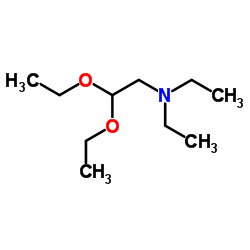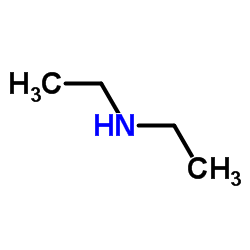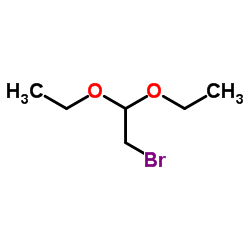3616-57-7
| 中文名 | 二乙氨基乙醛缩二乙醇 |
|---|---|
| 英文名 | 2,2-Diethoxytriethylamine |
| 中文别名 |
二乙基氨乙醛二乙缩醛
2,2-二乙氧基三乙胺 |
| 英文别名 |
Diaethylamino-acetal
diethyl-(2,2-diethoxy-ethyl)-amine 2,3-Diethoxytriethylamine Ethanamine,2,2-diethoxy-N,N-diethyl N,N-Diethyl-2,2-diethoxyethanamine DIETHYLAMINOACETALDEHYDE DIETHYL Diaethyl-acetalyl-amin 2,2-Diethoxy-N,N-diethylethanamine EINECS 222-801-6 2,2-diethoxyethyl(diethyl)amine 2,2-Diethoxyethyl(diethyl)amin Diaethyl-(2,2-diaethoxy-aethyl)-amin DIETHYLAMINOACETALDEHYDE DIETHYL ACETAL Diaethylamino-acetaldehyd-diaethylacetal 2,2-DIETHOXY-N,N-DIETHYL-ETHANAMINE Ethanamine, 2,2-diethoxy-N,N-diethyl- Diethylaminoacet |
| 密度 | 0.9±0.1 g/cm3 |
|---|---|
| 沸点 | 194.5±0.0 °C at 760 mmHg |
| 分子式 | C10H23NO2 |
| 分子量 | 189.295 |
| 闪点 | 65.0±0.0 °C |
| 精确质量 | 189.172882 |
| PSA | 21.70000 |
| LogP | 1.01 |
| 外观性状 | 透明液体 |
| 蒸汽压 | 0.4±0.3 mmHg at 25°C |
| 折射率 | 1.432 |
| 储存条件 | 密封储存,储存于阴凉、干燥的库房。 |
| 稳定性 | 常温常压下稳定,对水分敏感。 避免与不相容材料,水,湿空气接触。 与强氧化剂,强酸反应。 |
| 计算化学 | 1.疏水参数计算参考值(XlogP):1.6 2.氢键供体数量:0 3.氢键受体数量:3 4.可旋转化学键数量:8 5.互变异构体数量:无 6.拓扑分子极性表面积21.7 7.重原子数量:13 8.表面电荷:0 9.复杂度:99.1 10.同位素原子数量:0 11.确定原子立构中心数量:0 12.不确定原子立构中心数量:0 13.确定化学键立构中心数量:0 14.不确定化学键立构中心数量:0 15.共价键单元数量:1 |
| 更多 | 1. 性状:棕色或黄色透明液体 2. 密度(g/mL,25℃):0.85 3. 相对蒸汽密度(g/mL,空气=1):未确定 4. 熔点(ºC):未确定 5. 沸点(ºC,常压):194-195 6. 沸点(ºC,0.4mmHg):未确定 7. 折射率(n20/D):1.4189 8. 闪点(ºC):65 9. 比旋光度(º):未确定 10. 自燃点或引燃温度(ºC):未确定 11. 蒸气压(mPa,20ºC):未确定 12. 饱和蒸气压(kPa,25ºC):未确定 13. 燃烧热(KJ/mol):未确定 14. 临界温度(ºC):未确定 15. 临界压力(KPa):未确定 16. 油水(辛醇/水)分配系数的对数值:未确定 17. 爆炸上限(%,V/V):未确定 18. 爆炸下限(%,V/V):未确定 19. 溶解性:未确定 |
Synonym:2,2-Diethoxytriethylamin Section 2 - COMPOSITION, INFORMATION ON INGREDIENTS
Risk Phrases: 36/37/38 Section 3 - HAZARDS IDENTIFICATION EMERGENCY OVERVIEW
Irritating to eyes, respiratory system and skin.Moisture sensitive. Potential Health Effects Eye: Causes eye irritation. May cause chemical conjunctivitis and corneal damage. Skin: Causes skin irritation. May cause cyanosis of the extremities. Ingestion: May cause gastrointestinal irritation with nausea, vomiting and diarrhea. Inhalation: Causes respiratory tract irritation. Can produce delayed pulmonary edema. Inhalation at high concentrations may cause CNS depression and asphixiation. Chronic: Prolonged or repeated skin contact may cause dermatitis. Effects may be delayed. Section 4 - FIRST AID MEASURES Eyes: Immediately flush eyes with plenty of water for at least 15 minutes, occasionally lifting the upper and lower eyelids. Get medical aid. Skin: Get medical aid. Flush skin with plenty of water for at least 15 minutes while removing contaminated clothing and shoes. Wash clothing before reuse. Ingestion: Do not induce vomiting. If victim is conscious and alert, give 2-4 cupfuls of milk or water. Never give anything by mouth to an unconscious person. Get medical aid. Inhalation: Remove from exposure and move to fresh air immediately. If not breathing, give artificial respiration. If breathing is difficult, give oxygen. Get medical aid. Notes to Physician: Treat symptomatically and supportively. Section 5 - FIRE FIGHTING MEASURES General Information: As in any fire, wear a self-contained breathing apparatus in pressure-demand, MSHA/NIOSH (approved or equivalent), and full protective gear. During a fire, irritating and highly toxic gases may be generated by thermal decomposition or combustion. Use water spray to keep fire-exposed containers cool. Combustible liquid. Vapors may be heavier than air. They can spread along the ground and collect in low or confined areas. Containers may explode when heated. Extinguishing Media: Use water spray to cool fire-exposed containers. Do NOT get water inside containers. Use water spray, dry chemical, carbon dioxide, or appropriate foam. Section 6 - ACCIDENTAL RELEASE MEASURES General Information: Use proper personal protective equipment as indicated in Section 8. Spills/Leaks: Absorb spill with inert material (e.g. vermiculite, sand or earth), then place in suitable container. Clean up spills immediately, observing precautions in the Protective Equipment section. Remove all sources of ignition. Use a spark-proof tool. Provide ventilation. Do not get water inside containers. Section 7 - HANDLING and STORAGE Handling: Wash thoroughly after handling. Remove contaminated clothing and wash before reuse. Use only in a well-ventilated area. Avoid contact with eyes, skin, and clothing. Empty containers retain product residue, (liquid and/or vapor), and can be dangerous. Keep container tightly closed. Keep away from heat, sparks and flame. Avoid ingestion and inhalation. Do not allow contact with water. Do not pressurize, cut, weld, braze, solder, drill, grind, or expose empty containers to heat, sparks or open flames. Keep from contact with moist air and steam. Storage: Keep away from heat, sparks, and flame. Keep away from sources of ignition. Keep container closed when not in use. Store in a tightly closed container. Store in a cool, dry, well-ventilated area away from incompatible substances. Store protected from moisture. Section 8 - EXPOSURE CONTROLS, PERSONAL PROTECTION Engineering Controls: Facilities storing or utilizing this material should be equipped with an eyewash facility and a safety shower. Use adequate general or local explosion-proof ventilation to keep airborne levels to acceptable levels. Exposure Limits CAS# 3616-57-7: Personal Protective Equipment Eyes: Wear appropriate protective eyeglasses or chemical safety goggles as described by OSHA's eye and face protection regulations in 29 CFR 1910.133 or European Standard EN166. Skin: Wear appropriate protective gloves to prevent skin exposure. Clothing: Wear appropriate protective clothing to prevent skin exposure. Respirators: A respiratory protection program that meets OSHA's 29 CFR 1910.134 and ANSI Z88.2 requirements or European Standard EN 149 must be followed whenever workplace conditions warrant respirator use. Section 9 - PHYSICAL AND CHEMICAL PROPERTIES Physical State: Liquid Color: Clear Odor: None reported. pH: Not available. Vapor Pressure: Not available. Viscosity: Not available. Boiling Point: 194 - 195 deg C @ 760.00 mmHg Freezing/Melting Point: Not available. Autoignition Temperature: Not applicable. Flash Point: 65 deg C ( 149.00 deg F) Explosion Limits, lower: Not available. Explosion Limits, upper: Not available. Decomposition Temperature: Solubility in water: Specific Gravity/Density: 0.8500 g/cm3 Molecular Formula: C10H23NO2 Molecular Weight: 189.30 Section 10 - STABILITY AND REACTIVITY Chemical Stability: Stable under normal temperatures and pressures. Conditions to Avoid: Incompatible materials, ignition sources, moisture, excess heat, strong oxidants. Incompatibilities with Other Materials: Moisture, strong oxidizing agents, acids. Hazardous Decomposition Products: Nitrogen oxides, carbon monoxide, irritating and toxic fumes and gases, carbon dioxide, nitrogen. Hazardous Polymerization: Has not been reported. Section 11 - TOXICOLOGICAL INFORMATION RTECS#: CAS# 3616-57-7 unlisted. LD50/LC50: Not available. Carcinogenicity: Diethylaminoacetaldehyde diethyl acetal - Not listed by ACGIH, IARC, or NTP. Section 12 - ECOLOGICAL INFORMATION Section 13 - DISPOSAL CONSIDERATIONS Dispose of in a manner consistent with federal, state, and local regulations. Section 14 - TRANSPORT INFORMATION IATA Not regulated as a hazardous material. IMO Not regulated as a hazardous material. RID/ADR Not regulated as a hazardous material. Section 15 - REGULATORY INFORMATION European/International Regulations European Labeling in Accordance with EC Directives Hazard Symbols: XI Risk Phrases: R 36/37/38 Irritating to eyes, respiratory system and skin. Safety Phrases: S 24/25 Avoid contact with skin and eyes. WGK (Water Danger/Protection) CAS# 3616-57-7: No information available. Canada None of the chemicals in this product are listed on the DSL/NDSL list. CAS# 3616-57-7 is not listed on Canada's Ingredient Disclosure List. US FEDERAL TSCA CAS# 3616-57-7 is not listed on the TSCA inventory. It is for research and development use only. SECTION 16 - ADDITIONAL INFORMATION N/A |
| 危害码 (欧洲) | Xi:Irritant; |
|---|---|
| 风险声明 (欧洲) | R36/37/38 |
| 安全声明 (欧洲) | S26-S37/39 |
| 海关编码 | 2922199090 |
|
~20% 
3616-57-7 |
| 文献:WO2013/166952 A1, ; Page/Page column 24 ; |
|
~% 
3616-57-7 |
| 文献:Chemische Berichte, , vol. 30, p. 1514 |
| 海关编码 | 2922199090 |
|---|---|
| 中文概述 | 2922199090. 其他氨基醇及其醚,酯和它们的盐(但含一种以上含氧基的除外). 增值税率:17.0%. 退税率:13.0%. 监管条件:无. 最惠国关税:6.5%. 普通关税:30.0% |
| 申报要素 | 品名, 成分含量, 用途, 乙醇胺及其盐应报明色度, 乙醇胺及其盐应报明包装 |
| Summary | 2922199090. other amino-alcohols, other than those containing more than one kind of oxygen function, their ethers and esters; salts thereof. VAT:17.0%. Tax rebate rate:13.0%. . MFN tariff:6.5%. General tariff:30.0% |



